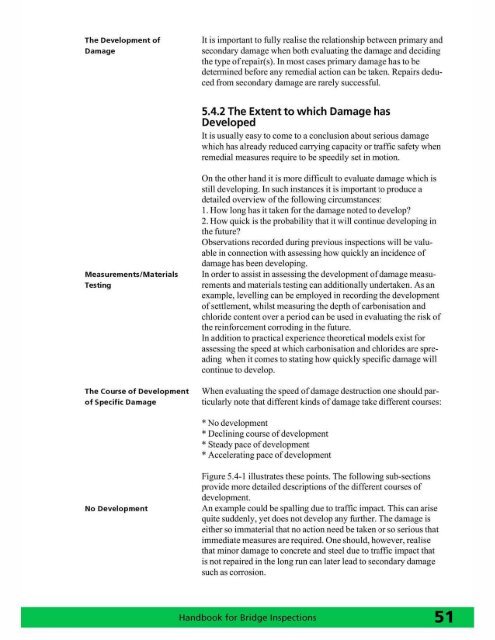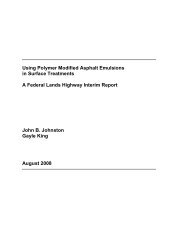Handbook for Bridge Inspections - TSP2
Handbook for Bridge Inspections - TSP2
Handbook for Bridge Inspections - TSP2
Create successful ePaper yourself
Turn your PDF publications into a flip-book with our unique Google optimized e-Paper software.
The Development o f<br />
Damage<br />
It is important to fully realise the relationship between primary and<br />
secondary damage when both evaluating the damage and decidi ng<br />
the type ofrepair(s).ln most cases primary damage has to be<br />
detennined be<strong>for</strong>e any remedial action can be taken. Repai rs deduced<br />
from secondary damage are rarely successful.<br />
5.4.2 The Extent to which Damage has<br />
Developed<br />
It is usually easy to come to a concl usion about serious damage<br />
which has already reduced carrying capac ity or traffic safety when<br />
remedial measures require to be speedil y set in motion.<br />
Measu rements/Materials<br />
Testing<br />
The Co urse of Development<br />
of Specific Damage<br />
On the other hand it is more difficult to evaluate damage which is<br />
sti ll developing. In such instances it is important to produce a<br />
detailed overview of the following circumstances:<br />
I. How long has it taken <strong>for</strong> the damage noted to develop?<br />
2. How quick is the probability that it will continue developing in<br />
the future?<br />
Observations recorded during previous inspections wi ll be valuable<br />
in connection with assessing how quickly an incidence of<br />
damage has been developing.<br />
In order to assist in assessing the development of damage measurements<br />
and materials testing can additionally undertaken. As an<br />
example, levelling can be employed in recording the development<br />
of settlement, whilst measuring the depth of carbonisation and<br />
chl oride content over a period can be used in evaluating the ri sk of<br />
the re in<strong>for</strong>cement corroding in the fut ure.<br />
In addition to practical experience theoretical models exist <strong>for</strong><br />
assessing the speed at which carbonisation and chlorides are spreading<br />
when it comes to Slating how quick ly specific damage will<br />
continue to develop.<br />
When evaluating the speed of damage destruction one should particu<br />
larly note that different kinds of damage take different courses:<br />
• No development<br />
• Decl ining course of development<br />
• Steady pace of development<br />
• Accelerating pace of development<br />
No Development<br />
Figure 5.4-1 ill ustrates these points. The following sub-secti ons<br />
provide more detailed descriptions of the different courses of<br />
development.<br />
An exampl e could be spalling due to traffic impact. This can arise<br />
quite suddenl y, yet does not develop any further. The damage is<br />
either so immaterial that no action need be taken or so serious that<br />
immediate measures are required. One should, however, real ise<br />
that minor damage to concrete and steel due to traffic impact that<br />
is not repaired in the long run can later lead to secondary damage<br />
such as corrosion.
















